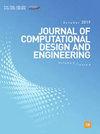Deterministic surface roughness effects on elastic material contact with shear thinning fluid media
IF 6.1
2区 工程技术
Q1 COMPUTER SCIENCE, INTERDISCIPLINARY APPLICATIONS
引用次数: 0
Abstract
Abstract The formation of lubrication films is described using the hydrodynamic lubrication theory, which is based on the Reynolds equation that includes shear thinning behaviors of lubricant. Contacting surfaces are considered to undergo elastic deformation owing to concentrated contact pressures that exceed 1.0 GPa in most engineering applications. Under the contact condition of a high load on a relatively small contact area, elastic deformation of contacting bodies directly influences the formation of the lubricated film. Elastohydrodynamic lubrication (EHL) analysis is applied to correctly analyze the lubricated contact. Under an EHL contact, the scale of the lubrication film thickness is frequently less than that of the surface roughness that results from either the manufacturing or running-in processes. In this work, surface roughness is considered in detail, and two-dimensional surface roughness is measured as that characterizing general engineering surface roughness. The deterministic method regarding the surface roughness is considered for computing EHL film formation under several contact conditions such as load, contact velocity, and elasticity of contacting materials.确定性表面粗糙度对弹性材料与剪切变薄流体介质接触的影响
摘要采用流体动力润滑理论描述润滑膜的形成,该理论基于雷诺方程,考虑了润滑剂的剪切减薄行为。在大多数工程应用中,由于集中接触压力超过1.0 GPa,接触面被认为发生弹性变形。在相对较小接触面积上的高载荷接触条件下,接触体的弹性变形直接影响润滑膜的形成。为了正确地分析润滑接触,应用了弹流动力润滑分析。在EHL接触下,润滑膜厚度的尺度通常小于由制造或磨合过程产生的表面粗糙度。在这项工作中,对表面粗糙度进行了详细的考虑,并测量了二维表面粗糙度作为一般工程表面粗糙度的特征。在载荷、接触速度、接触材料弹性等多种接触条件下,采用表面粗糙度的确定性方法计算EHL膜的形成。
本文章由计算机程序翻译,如有差异,请以英文原文为准。
求助全文
约1分钟内获得全文
求助全文
来源期刊

Journal of Computational Design and Engineering
Computer Science-Human-Computer Interaction
CiteScore
7.70
自引率
20.40%
发文量
125
期刊介绍:
Journal of Computational Design and Engineering is an international journal that aims to provide academia and industry with a venue for rapid publication of research papers reporting innovative computational methods and applications to achieve a major breakthrough, practical improvements, and bold new research directions within a wide range of design and engineering:
• Theory and its progress in computational advancement for design and engineering
• Development of computational framework to support large scale design and engineering
• Interaction issues among human, designed artifacts, and systems
• Knowledge-intensive technologies for intelligent and sustainable systems
• Emerging technology and convergence of technology fields presented with convincing design examples
• Educational issues for academia, practitioners, and future generation
• Proposal on new research directions as well as survey and retrospectives on mature field.
 求助内容:
求助内容: 应助结果提醒方式:
应助结果提醒方式:


